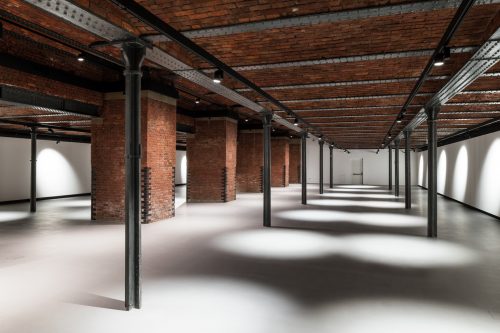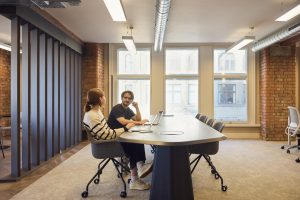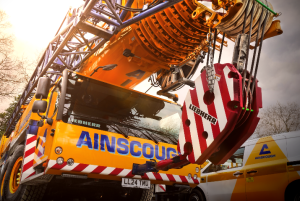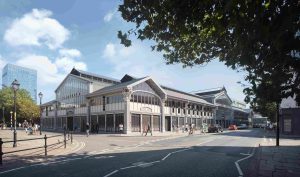£3.8m grant funds new special exhibitions gallery at Science and Industry Museum

A spectacular new 725 sq m flexible gallery is now complete at Manchester’s Science and Industry Museum and ready to originate and host some of the world’s best science exhibitions and experiences in the North.
This is thanks to a generous £3.8m grant from the DCMS (Department for Digital, Culture, Media and Sport) and additional support from other funders.
Designed by award-winning architectural practice Carmody Groarke, working alongside Manchester building contractor HH Smith & Sons, the transformation of the lower ground floor of the museum’s Grade II-listed new warehouse reveals grand industrial beauty with stunning modern and sustainable design. It opens-up public access as a gallery space to this part of the much loved museum’s globally significant site for the first time.
Director Sally MacDonald, said: “We are dedicated to inspiring audiences with ideas that change the world.
“This year has brought home to all of us how fundamentally science shapes our lives. As we all rebuild personally, socially and culturally, and look forward to better things in 2021, we can’t wait to share this phenomenal new exhibition space.
“Our new special exhibitions gallery will deliver a real step change in increasing access to incredible science exhibitions and collections. It is the first project in our long term multimillion-pound restoration programme to conserve our historic buildings, open up new spaces for all to enjoy, play and learn in and to generate vital skills opportunities to support our innovators of the future.“
The new warehouse was built in 1882 from brick, cast and wrought iron and sandstone to provide storage for the Great Western Railway and designed to support the weight of goods wagons entering the building and unloading cargo, which would have been moved through to the lower ground floor through ceiling hatches still visible today.
Used as museum stores until recently, the historic fabric of the lower ground floor has been revealed and restored, allowing visitors to experience the grandeur and scale of the original warehouse space while enjoying new exhibition experiences.
The original and the modern have been combined to pave the way for a sustainable gallery of the future, setting a new design standard for the rest of the masterplan of the museum to follow in years to come.
Key features include beautifully restored Victorian industrial architecture, including thick red brick walls with blue brick detail, steel and brick ‘jack arch’ ceilings, including a focal high section beneath the historic platform above – now the Textiles Gallery on the upper level.
These historic features have been enhanced with high quality contemporary materials and design including signature illuminated fibreglass panels in the external and front of house areas which light the space with a warm glow. In the gallery, new walls house all necessary services for the space and are a blank canvas for exhibitions.
An improved outdoor welcome area in the lower courtyard of the museum is fully accessible and provides stunning vistas under the historic Viaduct – also known as the Pineapple Line – with its monumental round cast iron and square sandstone pillars infilled with brick jack-arching.
This beautiful colonnade and area of the site will be incorporated in years to come in new connections and entrances between the Science and Industry Museum, The Factory and the developing St John’s and Castlefield neighbourhoods as this vibrant area of the city comes alive together.
This new gallery with its generous ceiling heights and apertures, dedicated object preparation and handling facilities, secure access routes and first rate environmental controls will enable the museum to display larger collection items and set works as well as provide a better visitor experience and visitor facilities for audiences to explore science in all its forms.
The £5m Special Exhibitions Gallery is being generously funded by the Department for Digital, Culture, Media and Sport, Wellcome and Garfield Weston Foundation, with further support from the Kirby Laing Foundation and The Zochonis Charitable Trust.
Andy Groarke, Carmody Groarke director, said “We were inspired by the powerful presence and character of the Victorian engineering and architecture when designing the new Special Exhibitions Gallery. By counterpointing the carefully restored historic building fabric with bold new materials, our architectural interventions reframe and repurpose the already wonderful spaces within the new warehouse as a backdrop for exhibitions and visitor welcome.”
Culture Minister, Caroline Dinenage, said: “This new gallery opens up a wealth of opportunity for the Science and Industry Museum and demonstrates the importance of not only the heart of Manchester but the whole of the North West.
“This exciting space will educate and inspire visitors from their local community and beyond and I am pleased that, with DCMS funding, the museum has been able to complete this important expansion. I can’t wait to see what fascinating exhibitions they have in store.”
Sir Richard Leese, leader of Manchester City Council, said: “The impact of this transformational project on our city will be immediate. The incredible new experiences that this spectacular gallery will bring will be integral to the cultural and skills recovery of our city through science, arts, technology and innovation for everyone.”
The museum remains temporarily closed and will re-open its doors when it is safe to do so in the coming weeks.
The inaugural exhibition hosted in the Science and Industry Museum’s new Special Exhibition Gallery will be Top Secret: From Ciphers to Cyber Security, curated by the Science Museum Group with the help of expert advisors, GCHQ, the UK’s intelligence and cyber agency.
Visitors will uncover the remarkable world of codebreaking, ciphers and secret communications by exploring more than a century’s worth of communications intelligence. From the First World War to the latest in cyber security, fascinating stories will be explored through hand written documents, declassified files and artefacts from the Science Museum Group’s and GCHQ’s historic collections.
Manchester is also home to GCHQ’s newest avowed office located in the heart of the city, Heron House in Albert Square.








